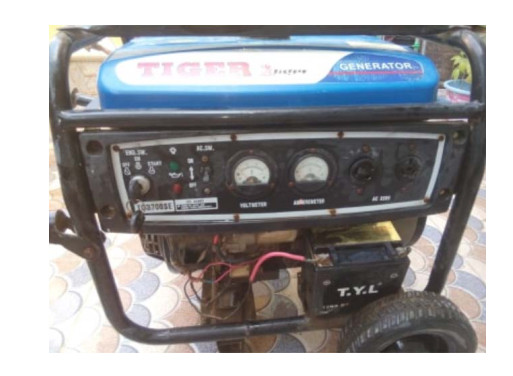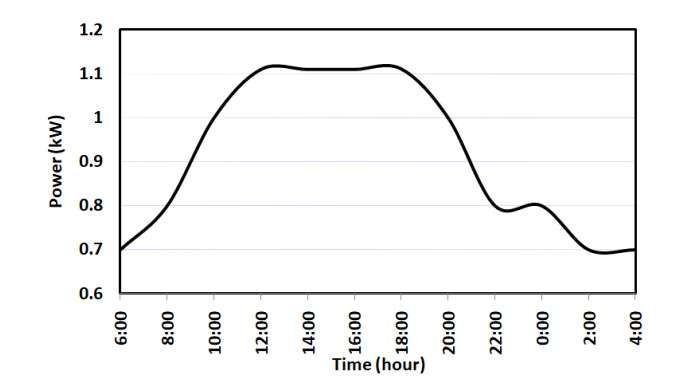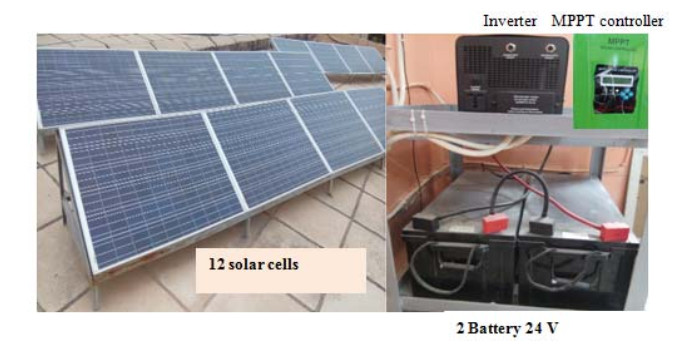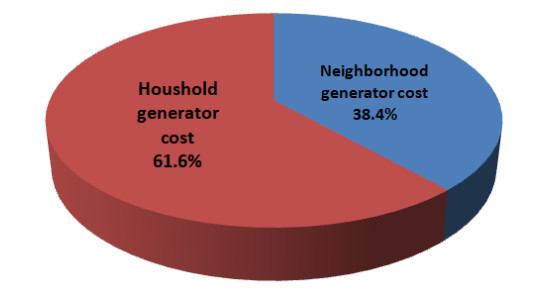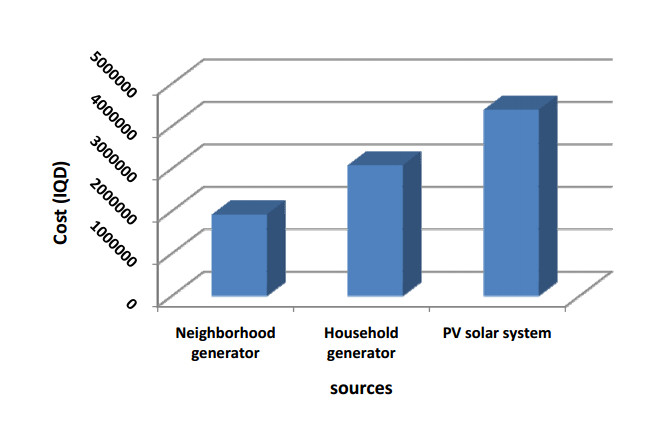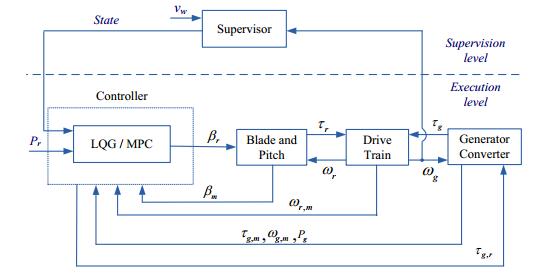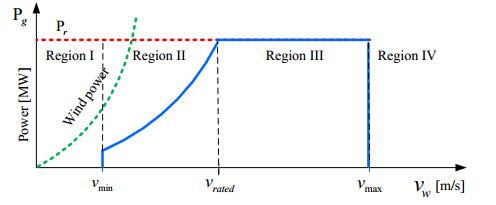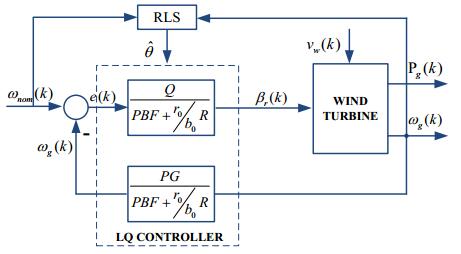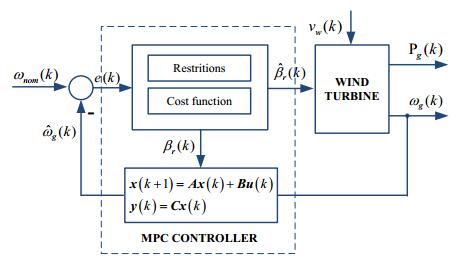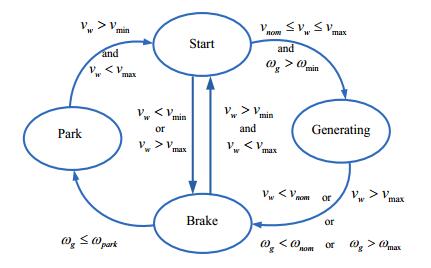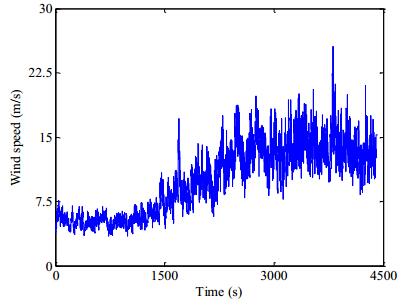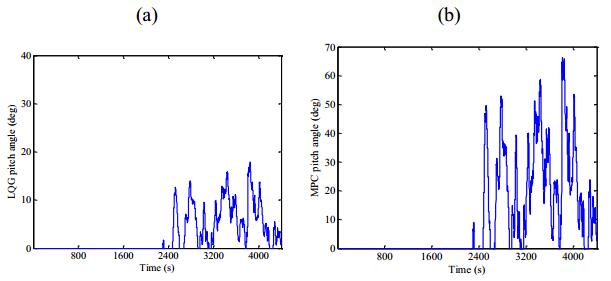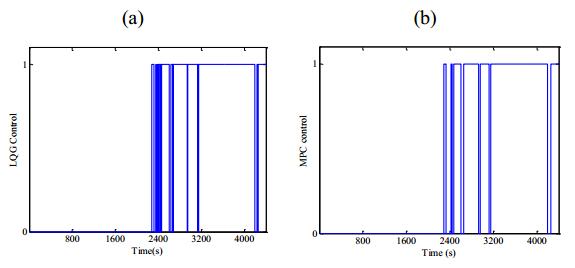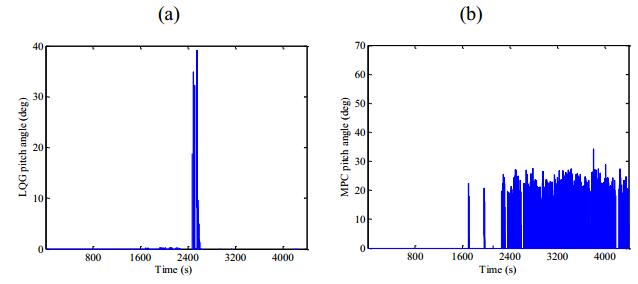This paper presents a simulation of onshore energy conversion system connected to the electric grid and under an event-based supervisor control based on deterministic version of a finite state machine. The onshore energy conversion system is composed by a variable speed wind turbine, a mechanical transmission system described by a two-mass drive train, a gearbox, a doubly fed induction generator rotor and by a two-level converter. First, mathematical models of a variable speed wind turbine with pitch control are studied, followed by the study of different controller types such as adaptive controllers and predictive controllers. The study of an event-based supervisor based on finite state machines is also studied. The control and supervision strategy proposed for the onshore energy conversion system is based on a hierarchical structure with two levels, execution level where the adaptive and predictive controllers are included, and the supervision level where the event-based supervisor is included. The objective is to control the electric output power around the reference power and also to analyze the operational states according to the wind speed. The studied mathematical models are integrated into computer simulations for the onshore energy conversion system and the obtained numerical results allow for the performance assessment of the system connected to the electric grid. A comparison of the onshore energy conversion system performance without or with the supervisor is carried out to access the influence of the control and supervision strategy on the performance.
Symbols: Am: Module area; C: Cost (IQD); CAh: Battery ampere capacity (A/h); Cwh: Battery watt capacity (W/h); d: Interest rate (%); E/m2: Energy received by PV (kW/m2); EL: Energy consumed by the load (kW); IC: Controller current (A); i: inflation rate (%); Nc: Number of controller; Npv: Number of solar cell; Vb: Battery voltage (V)
Abbreviations: MPW: Maintenance present worth; DOD: Permissible depth of discharge rate of a cell; IOP: Inverter output power; IQD: Iraqi Dinar; LCC: life cycle cost; ML: Maximum load; NC: Number of continuous cloudy days; PR: Performance ratio; SF: Safety factor
Greek letters: η module: PV module efficiency; ηb: Battery efficiency
Subscripts: n-g: Neighborhood generator; h-g: Household generator; ins: Installation; O&M: Operation and maintenance; b: Battery; c: Controller; inv: Inverter
1.
Introduction
The Electrical energy that produced from Photovoltaic solar system has become an excellant option to offset the growing demand of electricity around the world [1], reliable and has the potential to reduce the CO2 emissions [2]. Many countries have effectively turned on this type of energy due to the availability of the solar radiation over a wide range of the year. This led many researchers to focus their attention on developing and increasing the efficiency of photovoltaic solar systems to achieve an economic feasibility. In the last years, some of studies in literatures have examined the performance evaluation of photovoltaic solar systems. The evaluation was based on some main indicators that reported in these studies including: the total energy production, performance ratio (PR), and the system efficiency. Renu S. and Sonali G. [3] examined the annual performance of 11.2 kWp in India. The experimental examination showed that the total energy, efficiency and PR were 14.96 MWh, 13.42% and 0.78 respectively. In Italy, the performance analysis of two systems 395.61 kWp and 1042.29 kWp showed that the PR of the two systems was 0.872 and 0.832 respectively [4]. In Morocco, Charaf H. et al. [5] examined experimentally different modules and sizes of PV systems and showed that the Twidell was the best module with PR = 0.8 and an average efficiency of 16%. The performance assessment of 4.5 kWp in Nigeria showed that the energy production of the system was 14.52% from the size of the system [6]. In addition, the performance analysis of 1.72 kWp system in Ireland was presented experimentally by Ayompe L.M. et al.
[7]. The analysis showed that the annual total energy of the system was 885.1 kW h/kWp and system efficiency was 14.9%. On the other side, some of studies were focused on an economic feasibility of the PV solar systems depending on two main important indicators include life cycle and pay-back period. In Ireland, the experimental feasibility of 53.625 kWp PV system showed that the life cycle was 5.23 years [8]. In Japan, Yanxue L. et al. [9] simulated Techno economic performances of 5.0 kWp and showed that the net present value of system was over 20 years. As reported in Rodrigues S. et al. [10] study, the investment of 5 kWp system during 25 years in Germany and Italy was 13% higher than the most European countries. The payback period of 67.27 kWp system was recorded 11 years in United Kingdom [11]. In Palestine, the economic evaluation of 24.614 kWp system showed that dynamic pay-back period of system was 10.4 years [12]. The main goal of this work is to study the necessary of using the PV system to provide the required electricity for Iraqi houses. An economic feasibility investigation of 3 kWp PV solar system by calculating the life cycle cost was analyzed and compared with the two alternative sources represented in neighborhood and household generators.
2.
Problem and aim of the study
The electricity sector in Iraq suffered from deterioration since 1991 till now due to:
1. Old power generation plants, distribution and transmision networks;
2. Economic embargo in 1991;
3. American invasion in 2003;
4. Vandalism and neglecting from Iraqi goverment.
These factors led to severe power shortages to households, with power being available for less than 12 hours per day. To meet these power shortages, Iraqi families were forced to use other alternative sources such as the diesel neighborhood generators together with small gasoline portable generators (household), both of which have added a considerable financial burden on people. The financial burden includes the prices of generators, fuel and maintenance costs. In view of this phenomenon, the main goal of this work was to suggest and analyze the feasibility economic of a 3 kW PV solar system and compare it with the financial burden of the two generators (neighborhood and household). The study was conducted for a period of five years from (2014 to 2019) according to the current Iraqi market price. Questionnaire form was prepared to facilitate the calculation cost of neighborhood and household generators as shown in Table 1. The information of a questionnaire form was taken in the region where the neighborhood generator installed. Numbers of parameters were included in the questionnaire form, some of these parameters were related to the neighborhood generator (number and price of ambers) and other parameters were related to household generator (purchase cost, operation hours and maintenance cost).
3.
Cost of neighborhood generator
Neighborhood generator is a private diesel generator widely used in Iraq after 2003 to provide the electricity during the duration of national power outage. It is invested by a person and placed in a small neighborhood. The Iraqi government supplies the fuel to the generators at a reasonable price. So, the price of ampere from the neighborhood generator are controlled at 8000 IQD/ampere. According to the questionnaire form, the average of amperes demand of Iraqi family is equal to 4 amperes (equivalent to 1 kWh at 250 V supply). Therefore, the cost to be paid to the neighborhood generators for four amperes in one month is 32,000 IQD with total cost (Cn-g) in five years is 1,920,000 IQD (Cn-g = 4 amperes × 8,000 (IQD/amperes×month) × 60 month = 1,920,000 IQD).
4.
Cost of household generator
Iraqi markets contain different types of portable gasoline generators with different rated power (KVA) and different specifications. Gasoline generator model (Tiger-single phase-3KVA) with fuel capacity 10 liters and 0.5 liters oil were included in this study as shown in Figure 1. Schedule run of portable generator is from 5:00 am until 12:00 pm with an actual operation period 4 hours/day and the operation period depends on the national power outage and neighborhood generator off. The cost of household generator is listed in Table 2 including purchase, operation and maintenance cost. The cost calculation of household generator was investigated based on the data of Table 1.
5.
Proposed PV solar system
5.1. Load estimiation
The average maximum load was calculated in the summer and according to the actual need for household appliances as shown in Table 3. The actual operation period of appliances depends on the schedule of power shortages. Based on the table, the maximum energy demand is 1.11 kW then the maximum hourly load consumption should be 17.73 kWh. Figure 2 represents the actual load profile according to the number of operation hours.
5.2. Description of the solar system
A 3 kWp system with twelve solar module (Dusol DS60260W Dubi) made from polycrystalline silicon was proposed in this study according to the calculation of the load and sizing of components. The general specifications of the solar system components are summarized in Table 4 and its photograph shown in Figure 3.
5.3. Sizing of solar system
The sizing of the PV solar system components includes: number of solar panel, inverter output power, storage capacity of the battery and MPPT controller.
5.3.1. Number of solar cell
The total peak power and the module number of the proposed PV system can be calculated as [13]:
where: EL: Daily Energy consumption (17.73) kWh, PSH: peak sun hours (8.7) hours [14], ηR and ηin: charge regulator and inverter efficiencies (0.9 and 0.92) [13], SF: Safety factor (1.2) [15] and Pmodule: module power is selected (250) W.
5.3.2. Inverter sizing
The inverter output power (IOP) calculated according to [16]: IOP = (25−30)% greater than maximum load (ML) = 0.25 × 1.11 + 1.11 = 1.38 ≈ 1.5 kW. Therefore, the inverter specifications is selected as 1500 W, 24 V DC, 220 V AC, and 50 Hz.
5.3.3. Sizing of battery
As reported in [12], the watt hour capacity of pattery can be calculated as:
NC: Number of continuous cloudy days of the interested area = 0.5, DOD: Permissible depth of discharge rate of a cell = 0.75 [12], ηb: Battery efficiency = 0.85 [12].
The selected DC bus voltage is 24, therefore:
Number of batteries = 2 batteries of 12 V and 300 Ah connected in series to give 12 hours operation.
5.3.4. Sizing of MPPT controller
The maximum power of controller (Pmax-C) and number of controller (NC) can be calculated as [15]:
5.3.5. Life Cycle Cost (LCC) analysis
The LCC of the PV solar system can be classified into three parts: (ⅰ) components cost (ⅱ) installation cost (ⅲ) operation and maintenance cost. The details of calculating the components cost of the proposed PV solar system are represented in Table 5.
The present worth of the maintenance cost for the proposed PV solar system in 5 years can be calculated as [16,17]:
where: i is the inflation rate and assumed to be 3% and d is the interest rate assumed to be 9%. Therefore, the total life cycle of the PV system can be calculated as [18]:
5.3.6. Evaluation of results
The Iraqi government has not given much attention to use of PV solar energy for solving the problems in the electric power sector. In this paper, the cost and an economic feasibility investigation of proposed PV solar system was analyzed by calculating the life cycle cost. A comparison between the proposed system and two alternative sources (generators) that used together in Iraqi house was investigated. According to the results analysis, the total cost of the financial burden in five years for neighborhood generator was found to be (1,920,000 IQD ≈ 1600 USA$) while the cost of household generator was found to be (3,080,000 IQD ≈ 2566.6 USA$). Totally, the cost of the two generators was recorded about (5,000,000 IQD ≈ 4166.6 USA$) in five years. As shown in Figure 4, the cost of household generator represents 61.6% from the total cost of the two generators. The cost of neighborhood generator increases with an increasing in number of amperes that the Iraqi family needed. While, the cost of household generator depend on two parameters (operations hours and maintenance cost). The operation hours of household generator increase in the event of breakdowns of the neighborhood generator causing an increase in the cost of fuel and oil consumption and maintenance. On the other side, the life cycle cost LCC of the proposed PV solar system is found to be (4,386,366 IQD ≈ 3655 USA$). As shown in Figure 5, the cost of PV system is less than the cost of two generators by (613,634 IQD ≈ 511.3 USA$). In the other words, the LCC of two generators is greatly higher than PV solar cost with 12.27%.
6.
Conclusions
According to the economic feasibility analysis of the PV solar system comparing with the two types of generators, the following conclusions can be made:
1. The cost of household generator is greater than the neighborhood generator about 42.6%;
2. The breakdowns in the neighborhood generator increase the operation hours of the household generator then increase the fuel, oil and maintenance costs;
3. According to LCC, the cost of two generators is greatly higher than PV solar cost with 12.27%;
4. The PV solar system is more economic in Iraqi houses under the deterioration in the electricity sector. Furthermore, the PV solar not pollutes the environment as the case of using household and neighborhood generators.
Acknowledgements
The authors would like to thank the staff of Baqubah Technical Institute and Technical Engineering collage for their help.
Conflict of interest
All authors appear no conflicts of interest.









 DownLoad:
DownLoad:
